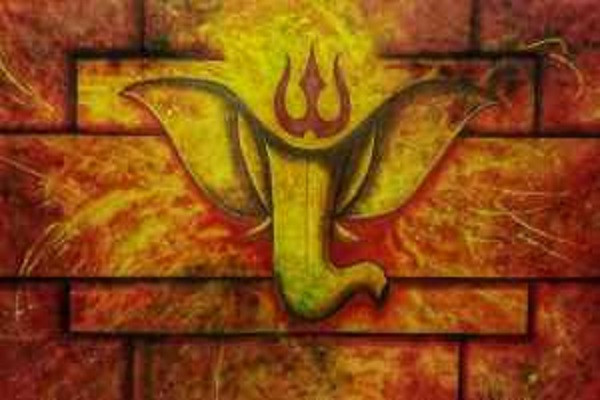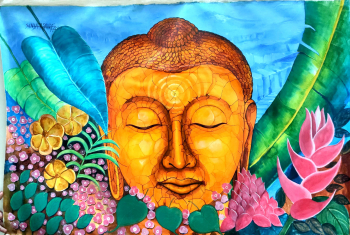
Ganesha Tanjore Paintings and other Indian artworks in Hinduism are the most respected deity and thus are a favourite painting idea. Ganesha paintings and idols are popular gifts among Hindus, whether for the inauguration of a new office or the 'Griha Pravesh' of a home. They also hold importance in decorating walls and empty spaces in office and home- for they are auspicious and considered to be a bit of good luck.
Children adore him because of his genial demeanour, while the elderly revere him because of his holy significance. People love to display Ganesha artwork and idols in their homes, but they rarely consider the impact that a Ganesha painting or idol might have on their lives.
We hope to educate our readers on the importance of having a Ganesha idol or artwork in their homes or workplaces through this blog. We also tend to help you learn about various kinds of Indian Artwork this 2022!
What Ganesha Tanjore Paintings Symbolizes?
In everything, there is a hidden significance. What draws you to buy a Ganesha painting if you're an art collector?
True, there are a variety of components that can keep you engaged. Ganesha's eye, for example, reflects the highest level of concentrate in his skull.
Similarly, large ears suggest that listening takes precedence over speaking. Ganesha's little mouth denotes that a few words if said with integrity, can accomplish much.
In addition, Ganesha's large tummy shows that you should be ready to eat whatever comes your way (good or bad). Ganesha's elephant head is his most prominent feature, symbolizing auspiciousness, power, and intellectual prowess. His form encapsulates all of the elephant's characteristics. The elephant in the forest's largest and most powerful animal. He is, however, compassionate and, miraculously, a vegetarian, so he does not kill to eat. He is quite devoted and loyal to his caretaker, and he is easily swayed by love and kindness. Ganesha is also kind and forgiving, and he is moved by the love of his worshippers. When offended, however, the elephant may destroy an entire forest and becomes a one-man army. Ganesha is also extremely powerful and maybe brutal when it comes to dealing with evil.
Various types of Ganesh Tanjore paintings are:
-
Flute Ganesha Tanjore Painting
Many gods and goddesses are shown with a musical instrument in their hands. Some are intimately linked to a particular instrument. Goddess Saraswati plays the veena, Lord Krishna plays the flute, and so forth. Ganapati's idols are frequently portrayed with a musical instrument, such as a flute, mridangam, or tablas. When you look at Lord Ganesha's idols and representations, you'll notice a wide range of traditional musical instruments. Have you ever wondered why that is?
Lord Ganesha is regarded as a patron of the arts and sciences, and one of the arts is music. Lord Ganesha is also a heavenly creature who lives in the universe, which is considered to be filled with holy rhythm and music.
Lord Ganesha is a heavenly creature who adores all things beautiful and pleasurable, which music brings. It's no surprise, then, that Lord Ganesha is known as Nadapratithishta, which means "music lover." Nadapratithishta is one of Lord Ganesha's 108 names.
As a result, Nadapratithishta is regarded as a sacred name, and many parents choose this name for their son. The Sun is the baby's birth star, and he is a Scorpio according to western zodiac signs. Many people enjoy purchasing small idols of Ganapati playing various instruments and displaying them in a prominent location in their homes to depict a Ganesha jugalbandi.
-
Lakshmi Ganesha Saraswathi Tanjore Painting
Lakshmi (Sanskrit: ) is a Hindu goddess who represents money, prosperity (both material and spiritual), fortune, and beauty. Saraswati, the Goddess of Music, Wisdom, and Knowledge, is depicted playing the Veena in this picture. The addition of a lotus and a swan to the design adds to the purity and beauty meaning.
Saraswati is the celestial consort of Lord Brahma, the universe's Creator, according to Hindu mythology. Saraswati represents Brahma's creative power because knowledge is required for creation. All those who are engaged in learning, especially students, teachers, scholars, and scientists, revere Goddess Saraswati.
When you think of Ganesha, you might think of a pleasant, slightly humorous elephant-headed God whom you pray to first before beginning anything new. He is a remover of impediments. Ganesha has deeper symbolic significance; his enormous ears and head suggest that he has achieved wisdom by listening to and thinking on the Vedic everlasting truths. His head and trunk are shaped like the Om, our most sacred emblem, which represents the primordial sound of creation and our most potent mantra in prayer and meditation. The elephant is particularly significant since it is a herbivore that eats exclusively vegetarian food, as well as a peaceful and gentle animal with great strength that it only employs when necessary. The huge tummy of Lord Ganesha is supposed to contain
-
Small Ganesha Tanjore Painting
Bal Ganesha, also known as Baby Ganesha, is a childlike version of the Hindu god Ganesha (Ganapati), the elephant-headed god of wisdom and fortune.
Few depictions of Ganesha as a little child being massaged by his parents, Parvati and Shiva, exist.
An infant Ganesha is also shown in the lap or over the shoulder of his mother Parvati.
Bala Ganapati is depicted as seated or crawling in many depictions. Ganesha is depicted as an infant crawling on his knees in bronze from South India. He possesses four arms. While two of them carry sweet balls, his trunk holds the modaka, His favourite sweet, and curls towards his open mouth, signalling that he is preparing to eat it.
-
Kan Drishti Ganapathi Tanjore Painting
Shuba Drishti Ganapathy is an all-powerful splendid divine form created with Sage Agastya's unique and potent blessings, the foremost of the eighteen Siddhas. Lord Vinayaka has the power to alter ideas (from negative to good). That is why, as Lord Ganapathy, He has landed on this globe as Sri Shuba Drishti Ganapathy, uniting all heavenly energies within Himself. In this Kali Yuga, Sri Shuba Drishti Ganapathy is Ganesha's 33rd form, who has risen for the good of the people in this extremely gorgeous form. Mahaganapathi in this unusual form is a fusion of multiple Supreme incarnations all bundled into one.
One might benefit from worshipping Drishti Ganapathy at home. The image or idol of Shuba Drishti Ganapathy must be placed on the south wall, facing north. It can be maintained in the prayer room or the drawing-room, where it can catch the attention of all guests to the house, rather than only on the front entrance (as many of them do). Remove all the negative effects brought on by casting an evil eye on oneself and family members, and bring enormous wealth and prosperity.
-
Dancing Ganesha Tanjore Painting
People pray to Ganesha for good luck, especially before embarking on a journey, beginning a business, getting married, or starting a new year, or when facing a tough task, such as completing an exam or performing a dance. Ganesha is also known as the Lord of Learning and the Arts, as well as the Lord of the Harvest. An idol of Ganesha in the sitting position, also known as the lalitasana, is suitable for worshipping inside the confines of your house. According to Vastu experts, the sitting Ganesha indicates a calm and controlled personality and promotes a pleasant household atmosphere.
Wrap up:
In the process of learning about various kinds of Ganesha Tanjore Paintings-get a chance to learn and buy more Indian Artwork. With Indian Art Ideas- you can make sure of getting the best deals with your ordered painting- delivered in time!
Reach out for more kinds of Tanjore paintings and let your house sparkle like never before.





















